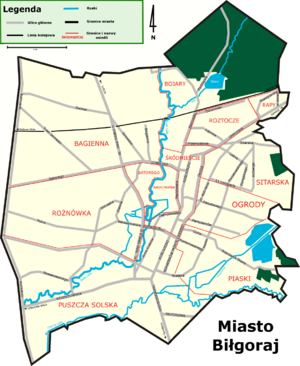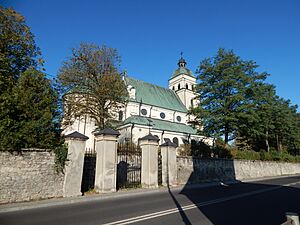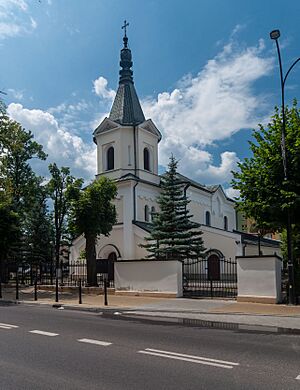Biłgoraj facts for kids
Quick facts for kids
Biłgoraj
|
|||
|---|---|---|---|

Modernized City Hall of Biłgoraj
|
|||
|
|||
 |
|||
| Country | |||
| Voivodeship | |||
| County | Biłgoraj | ||
| Gmina | Biłgoraj (urban gmina) | ||
| Established | 1578 | ||
| Town rights | 1578 | ||
| Area | |||
| • Total | 21.1 km2 (8.1 sq mi) | ||
| Highest elevation | 212 m (696 ft) | ||
| Lowest elevation | 184 m (604 ft) | ||
| Population
(31 December 2021)
|
|||
| • Total | 25,838 | ||
| • Density | 1,225/km2 (3,170/sq mi) | ||
| Time zone | UTC+1 (CET) | ||
| • Summer (DST) | UTC+2 (CEST) | ||
| Postal code |
23-400 to 23-401
|
||
| Area code(s) | +48 84 | ||
| Car plates | LBL | ||
| Voivodeship roads | |||
Biłgoraj is a town in south-eastern Poland. About 25,800 people lived there in December 2021. It is located in the Lublin Voivodeship, which is like a state or province in Poland. Biłgoraj is south of the city of Lublin and is the main town of Biłgoraj County.
Historically, Biłgoraj is part of a region called Lesser Poland. It sits in the south-eastern part of this area, close to another historical land called Red Ruthenia. The town is surrounded by a large forest known as Solska Forest, and three rivers flow through it.
Contents
What's in a Name?
The name of Biłgoraj likely comes from a hill. This hill was called Biely Goraj, and it's where the town was first built in the 1500s.
Where is Biłgoraj?
Biłgoraj is in the northern part of the Sandomierz Basin, close to a beautiful area called Roztocze. The town is surrounded by the Solska Forest, and it's only about 20 kilometers (12 miles) from Roztocze National Park.
The weather in Biłgoraj is mild. In July, the average temperature is about 18°C (64°F). In January, it's around -2.8°C (27°F). Four small rivers flow through the town: Biała Łada, Czarna Łada, Osa, and Próchnica. Biłgoraj is built on land that is between 184 and 212 meters (604 to 696 feet) above sea level. The town covers about 20 square kilometers (7.7 square miles), and 9% of this area is covered by forests.
A Look Back in Time
Early Days: From the 1500s to 1918
The area where Biłgoraj is now was once covered by thick forests and swamps. This made it hard for people to settle there. In the early 1500s, a noble family called Gorajski started the first settlements.
The town of Biłgoraj was officially founded in 1570 by Adam Gorajski. King Stefan Batory gave it town rights in 1578. The main market square was built on the Biely Goraj hill. The town was easy to defend because it was surrounded by rivers. Biłgoraj grew quickly because it was on a busy trade route between Jarosław and Lublin.
At first, Biłgoraj had defensive walls and watchtowers. Most houses were made of wood, which meant fires were a big problem. The town was also destroyed twice during wars in the mid-1600s. First, in 1648, it was burned by Cossacks. Then, in 1655, the Swedes destroyed it during a period known as the Deluge.
Biłgoraj was important during the Bar Confederation, a Polish uprising. Many small battles happened near the town. After Poland was divided by other countries, Biłgoraj became part of the Austrian Empire in 1772. Later, in 1809, it joined the Duchy of Warsaw, which was controlled by Russia after 1815.
By the late 1700s, about 3,000 people lived in Biłgoraj. This number grew to 6,000 by 1865. At that time, it was the third largest town in the Lublin Governorate. In 1806, a local businessman named Stanisław Nowakowski bought Biłgoraj. He built a palace in the Roznowka area of the town. The Nowakowski family owned the town until 1850.
Between the World Wars: 1918 to 1939
In 1918, Biłgoraj became part of the newly independent Second Polish Republic. By 1921, its population was around 5,600. Electricity came to the town in 1928. However, Biłgoraj remained a simple town, with most houses still made of wood. Before World War II, Biłgoraj was home to a large Jewish community.
World War II and Its Aftermath
On September 11, 1939, a group of German agents set fire to Biłgoraj, destroying much of it. German troops entered the town a few days later. The German air force also bombed Biłgoraj twice. Polish soldiers fought the German army in the Battle of Biłgoraj in mid-September 1939. The Germans finally took control of the town on September 17. Later, Soviet troops briefly entered Biłgoraj before the town became part of the German-ruled General Government. A Jewish ghetto was created in June 1940.
During the German occupation, Biłgoraj was a key center for the Polish resistance movement. Local groups like the Home Army fought against the Germans. The surrounding Solska Forest was a hiding place for Polish fighters. They often attacked German units in Biłgoraj. A famous event happened on September 24, 1943, when the Home Army attacked Biłgoraj's prison. They freed 72 prisoners.
There was also Jewish resistance in the Biłgoraj area. Many Jewish people from Biłgoraj were forced to leave their homes. Most of Biłgoraj's Jewish community did not survive the war. Only about 50 Jewish people from Biłgoraj were still alive when the war ended.
The Germans left Biłgoraj on July 24, 1944. The war had destroyed 80% of the town. It also lost half of its population.
After the War
After 1945, Biłgoraj was rebuilt. By 1975, it had become an important industrial center in the region. The town has been part of the Lublin Voivodeship since 1999.
Historic Places to See
- Stanisław Nowakowski's Park – This old park is also known as Małpi Gaj (Monkey Marsh). It's what's left of a palace garden from the 1600s. You can still see the original gate to the town and the old garden keeper's cottage.
- Church of the Assumption of Mary – This beautiful church was built in the early 1600s in the Polish Baroque style. It's located on Trzeciego Maja Street, near the main square.
- Church of St. George – This smaller church on Tadeusz Kościuszko Street was built in the 1800s. It used to be an Eastern Orthodox church.
- Mary Magdalene Church – Located in the Puszcza Solska district, this church was built in the early 1920s. It's surrounded by old buildings from a Franciscan monastery, including a small bell tower and a 1600s chapel.
- Zagroda Sitarska Museum – This is an open-air museum on Nadstawna Street. It was built in the early 1800s. The main building is a wooden house that shows how sieves were traditionally made.
Getting Around Biłgoraj
Biłgoraj is connected by two main regional roads. Road 835 runs north-south, from Lublin to Przemyśl. Road 858 runs east-west, from Zamość to Nisko. The town also has a train station on a line that goes from Zamość to Stalowa Wola. The closest airport is Rzeszów-Jasionka Airport, about 110 kilometers (68 miles) to the south.
What Biłgoraj Makes
Biłgoraj is home to the headquarters and main factories of Black Red White. This company is one of the biggest furniture makers in Poland. The town is also known for its wine industry, with bottling plants nearby. Other important industries include knitting and making cardboard packaging, wooden doors, and windows.
Local Traditions
Biłgoraj is a special place for local traditions and folk art. This is partly because it's surrounded by forests, which made it a bit isolated in the past. You can find unique "Biłgoraj-style" houses and many small shrines along the roads.
For centuries, Biłgoraj was famous for making sieves. The town has a Regional Museum and an Open-air museum called Zagroda Sitarska, where you can learn about this history. Because it's close to Roztocze National Park, many tourists visit Biłgoraj. The town also has a beautiful Baroque church from the 1600s and many other historic monuments.
Town Partnerships
Biłgoraj has "twin town" or "sister city" relationships with several cities around the world. These partnerships help people from different countries learn about each other.
Biłgoraj is twinned with:
 Afula in Israel
Afula in Israel Bílina in Czech Republic
Bílina in Czech Republic Crailsheim in Germany
Crailsheim in Germany Kelmė in Lithuania
Kelmė in Lithuania Stropkov in Slovakia
Stropkov in Slovakia Novovolynsk in Ukraine
Novovolynsk in Ukraine
Biłgoraj used to be twinned with Kruhlaye in Belarus, but this partnership ended due to Belarus's involvement in the 2022 conflict in Ukraine.
Famous People from Biłgoraj
- Shmuel Atzmon-Wircer (born 1929), who created the Yiddishpiel Theatre in Israel.
- Konrad Bartoszewski (1914–1987), a writer and a leader of a resistance group during World War II.
- Isaac Bashevis Singer (1903–1991), a famous Jewish-American writer and Nobel Prize winner. He lived in Biłgoraj as a child, and the town appears in many of his stories.
- Israel Joshua Singer (1893–1944), a Polish-Jewish writer and Isaac Bashevis Singer's brother.
- Justyna Bąk (born 1974), a former world record holder in the 3000 meters steeplechase race.
- Shmuel Ben-Artzi (1914–2011), an Israeli writer, poet, and educator. He was also the father-in-law of Israeli Prime Minister Benjamin Netanyahu.
- Joanna Kaczor (born 1984), a volleyball player.
- Marzena Karpińska (born 1988), a weightlifter.
- Harry Keitel, the father of famous actor Harvey Keitel.
- Stefan Knapp (1921–1996), a painter.
- Janusz Palikot (born 1964), a politician and businessman.
- Roman Tokarczyk (born 1942), a lawyer and philosopher.
- Kazimierz Węgrzyn (born 1967), a footballer.
Images for kids
See also
 In Spanish: Biłgoraj para niños
In Spanish: Biłgoraj para niños









